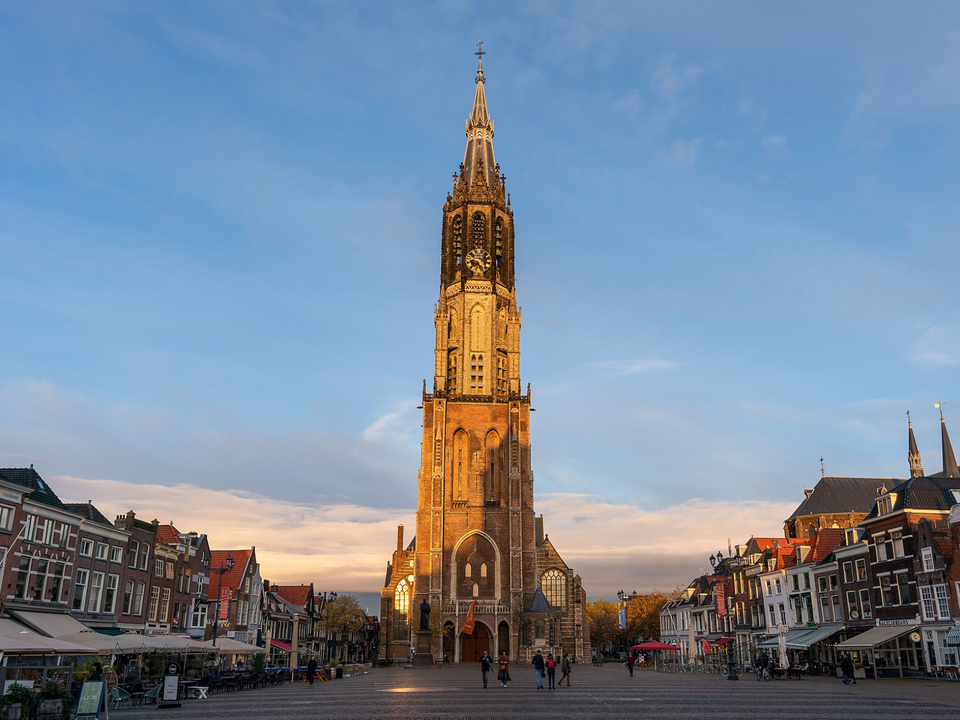
Nieuwe Kerk Orange Route
The church is built between 1383 and 1510. The late Gotic cross basilica was dedicated to the Holy Virgin Mary, but got during construction already its second patron saint, Saint Ursula.
It was a richly decorated church. During the iconoclasm, in 1566, a lot of altarpieces, statues and sacred vessels were destroyed. During the reformation of 1572 the catholic church is passed on to the 'reformers'. You can visit the church from Monday till Saturday every week.
The tower of the Nieuwe Kerk, built between 1396 and 1496, is the second highest church in the Netherlands with 108,75 meters. Only the Cathedral Tower in Utrecht is higher at 112 meters.
Crypts of the Royal Family
The crypts of the Royal House are located at the choir of the Ni…
It was a richly decorated church. During the iconoclasm, in 1566, a lot of altarpieces, statues and sacred vessels were destroyed. During the reformation of 1572 the catholic church is passed on to the 'reformers'. You can visit the church from Monday till Saturday every week.
The tower of the Nieuwe Kerk, built between 1396 and 1496, is the second highest church in the Netherlands with 108,75 meters. Only the Cathedral Tower in Utrecht is higher at 112 meters.
Crypts of the Royal Family
The crypts of the Royal House are located at the choir of the Nieuwe Kerk. Willem van Oranje was the first person placed near these crypts in 1584. The grave of the family Nassau used to be in the Grote or Onze-Lieve-Vrouwenkerk in Breda. The Spaniards occupied Breda. That is why they decided to move Willem van Oranje to the Nieuwe Kerk. First in a crypt in the choir on a catafalque. In 1612, Loise de Coligny, his fourth wife, insisted on the States General for a representative sculpture. Still, in the same year Hendrick de Keyser, an architect and sculptor, got the project to build a grave monument.
Between the choir and the central nave stands a model of the crypt with an overview of all the Royal Family members who are placed there. The crypt is closed with a big closing rock. They only open the rock door when a new member of the Royal Family is being placed there. The latest members who were placed in the crypt were Prince Claus in 2002 and Princess Juliana and Prince Bernhard in 2004.
Mausoleum
In 1612, Hendrick de Keyser got the project to create a marble mausoleum exactly above the place where Willem his remains are. Hendrick got inspired by the French Royal tombs, especially the one from Hendrik II and Catherina di Medici at the cathedral of St. Denis close to Paris. This was because the States General wanted a monument representing the royal status of Willem van Oranje, the founder of the republic.
The monument has a lot of symbolic elements, like the four fundaments of Willem van Oranje, the founder of the republic, as the fundaments on which they built the republic. The monument is also a national symbol of the republic. At the corners are four female figures displayed. They are personifications of the values of Willem, who were very important for his ideas. These values are Freedom, Justice, Religion and Power, Bravery and Courage.
De ramen van de Nieuwe Kerk
Twee keer zijn de gebrandschilderde ramen verloren gegaan. De eerste keer gebeurde dat bij de stadsbrand in mei 1536. Bij de ontploffing van het Delftse kruithuis in oktober 1654 werden de ramen opnieuw verwoest.
The windows of the Nieuwe Kerk
The stained glass windows have already been lost two times. The first time was during a city fire in May 1536. During the explosion of the Delft gunpowder house, in October 1654, the windows were destroyed for a second time.
In 1923 Queen Wilhelmina celebrated her 25th anniversary. The National Committee was in charge of the National gift, which was the restoration of the choir and the Royal Crypt. In response, the Wilhelmina window was donated (in the south transept). Furthermore, several windows were donated to the Oranjehuis, in particular behind the mausoleum. The other windows have designs of the Old and New Testament. In the North transept, there is a Hugo Grotius window. In 14 scenes is the life of Hugo de Groot described.